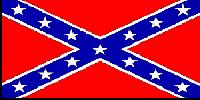The
American Civil War 
Led by Colonel J. Foster Marshall, the 1st Regiment of Rifles (also
known as Orr's Rifles after their illustrious founder) fought back the
first stubborn Union attacks, then joined another regiment to charge
and rout a newly advancing Federal line. Hours later, their greatest
test came when Union General Phil Keamy mounted an overwhelming assault
on Jackson's left, where only the South Carolinians could prevent a
disastrous breakthrough. Their ranks thinned, and exhausted after
almost a day's fighting, Orr's Rifles took the brunt of the attack,
determined not to yield their ground or colors, stopping assault after
assault, then driving back their foe with bayonets when ammunition ran
out. A Confederate officer remembered, "this regiment, after a terrible
contest, forced [the enemy] back to their cover. It is these
hand-to-hand fights that make war devil's work; for it is they which
excite all the bloodthirsty passions."Against all odds, the South
Carolinian brigade held, and that night "slept upon the field it had
earned, if ever men earned ground," as an officer recalled. Stonewall
Jackson later applauded the valor of the South Carolinians, crucial to
the Southern victory at Second Manassas.
The volunteers of the 1st South Carolina Regiment of Rifles chiefly hailed from the counties of Abbeville, Anderson, Marion and Pickens. Organized at Sandy Springs, South Carolina, in July 1861, the regiment came to be called Orr's Rifles, after its founder Colonel James L. Orr, who would later serve as governor of South Carolina and U.S. minister to Russia. Stationed on Sullivan's Island for its first nine months, the regiment's initial light duty inspired the sobriquet "the Pound Cake Regiment." But soon it would distinguish itself in great battles.
In April 1862, Orr's Rifles was assigned to Virginia, joining the
brigade of General Maxcy Gregg in General A.P. Hill's division. At
Games' Mill on June 27, the 1st Rifles fought along with General Thomas
Stonewall Jackson's army. Under the command of Colonel J. Foster
Marshall, the 1st Rifles heroically followed their colors for several
hundred yards through heavy fire, then routed a Union battery and drove
off a large force of New York Zouaves in hand-to-hand fighting. Of 538
engaged, the 1st Rifles had 81 killed and 234 wounded, but helped carry
the day. Two months later, at their legendary stand at Second Manassas,
the 1st Rifles suffered 116 casualties. The Battle of Fredericksburg,
fought in December 1862, cost the regiment another 170 casualties. That
Christmas, Dr. Thomas Watson of the 1st South Carolina wrote his wife
of the men's fine spirits despite the terrible losses.
In General Samuel McGowan's brigade at Chancellorsville, the 1st Rifles attacked Union emplacements in a morning fog. With colors hardly visible, almost half of the 233 engaged were lost as volley after murderous volley was exchanged. After more bitter fighting at Gettysburg and the Wilderness, the 1st Rifles held a key trench at Spotsylvania against Federal rifle fire so intense that it eventually felled an oak tree 22 inches in diameter! The unit's remnants continued their gallant tradition at Cold Harbor, and endured further hardships in the Petersburg trenches. At war's end, the 1st South Carolina surrendered nine officers and 148 enlisted men.

1st
South Carolina Regiment
On August 29,1862,25,000 proud Confederate troops of General Thomas
"Stonewall" Jackson took defensive positions at Manassas (Bull Run) in
northern Virginia, the scene of a great Southern victory a year before.
General John Pope, the new commander of the Union Army of Virginia,
massed over 60,000 Federals in the area, bent on destroying Jackson's
army before Confederate Generals James Longstreet and Robert E. Lee
could come to his aid. Guarding Jackson's critical left flank was
General Maxcy Gregg's South Carolina brigade, including the 1st South
Carolina Regiment of Rifles that would gain immortal glory on that day.The Regiment Stands Fast in Desperate Hand-to-Hand Fighting
The volunteers of the 1st South Carolina Regiment of Rifles chiefly hailed from the counties of Abbeville, Anderson, Marion and Pickens. Organized at Sandy Springs, South Carolina, in July 1861, the regiment came to be called Orr's Rifles, after its founder Colonel James L. Orr, who would later serve as governor of South Carolina and U.S. minister to Russia. Stationed on Sullivan's Island for its first nine months, the regiment's initial light duty inspired the sobriquet "the Pound Cake Regiment." But soon it would distinguish itself in great battles.
Devastating Casualties in the Thick of the Fighting
In General Samuel McGowan's brigade at Chancellorsville, the 1st Rifles attacked Union emplacements in a morning fog. With colors hardly visible, almost half of the 233 engaged were lost as volley after murderous volley was exchanged. After more bitter fighting at Gettysburg and the Wilderness, the 1st Rifles held a key trench at Spotsylvania against Federal rifle fire so intense that it eventually felled an oak tree 22 inches in diameter! The unit's remnants continued their gallant tradition at Cold Harbor, and endured further hardships in the Petersburg trenches. At war's end, the 1st South Carolina surrendered nine officers and 148 enlisted men.